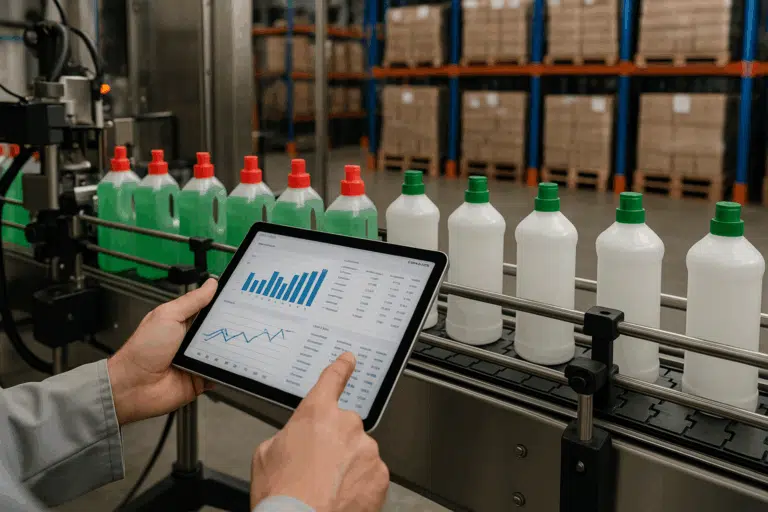Just-in-Time (JIT) inventory management can revolutionize your business operations by optimizing inventory levels, improving efficiency, and minimizing costs. By implementing JIT principles and leveraging the power of real-time data analysis, you can achieve seamless supply chain integration and meet customer demands with precision. Embrace the benefits of JIT inventory management and propel your business towards sustained success in today’s competitive marketplace.
This article explores the power of Just-in-Time (JIT) inventory management and shows how to optimize your operations for maximum efficiency and cost-effectiveness. Discover key strategies, benefits, and implementation tips in this comprehensive guide.
Table of Contents
ToggleWhat Is Just-in-Time Inventory Management?

Just-in-Time (JIT) inventory management is a strategy used by businesses to minimize inventory holding costs and improve operational efficiency. It involves receiving inventory items from suppliers or producing them internally just in time for their use in the production process or to fulfill customer orders.
The key principle of JIT is to have inventory available exactly when it is needed, in the required quantity, and of the highest quality. By reducing inventory levels and minimizing storage space, JIT helps companies avoid excess inventory costs, obsolescence, and waste.
JIT relies on close coordination and communication with suppliers to ensure timely delivery of raw materials and components. It also emphasizes efficient production processes, reduced lead times, and continuous improvement initiatives such as lean manufacturing and waste reduction techniques.
Overall, JIT inventory management aims to streamline operations, minimize inventory-related costs, and increase responsiveness to customer demand.
How Does “Just-In-Time” (JIT) differ from traditional inventory management methods?
Just-in-Time (JIT) inventory management differs from traditional inventory management methods in several ways:
- Inventory levels: JIT aims to minimize inventory levels by keeping only the necessary amount of inventory on hand. Traditional methods often maintain larger inventories as a buffer against uncertainties and fluctuations in demand.
- Timing of inventory replenishment: JIT focuses on receiving inventory items just in time for their use in production or customer orders. Traditional methods may involve ordering and receiving inventory in larger quantities and storing them for longer periods.
- Lead times: JIT aims to reduce lead times by working closely with suppliers to ensure timely delivery of materials. Traditional methods may have longer lead times due to larger order quantities and longer procurement processes.
- Cost structure: JIT strives to minimize inventory carrying costs, such as storage, obsolescence, and handling. Traditional methods may have higher inventory holding costs due to larger inventory levels and associated expenses.
- Supplier relationships: JIT requires close coordination and collaboration with suppliers to ensure timely deliveries. Traditional methods may have more transactional relationships with suppliers.
- Production efficiency: JIT emphasizes efficient production processes, reduced setup times, and waste reduction techniques like lean manufacturing. Traditional methods may not focus as heavily on these aspects.
- Flexibility and responsiveness: JIT enables companies to be more responsive to changes in customer demand and market conditions due to lower inventory levels and reduced lead times. Traditional methods may have limited flexibility and responsiveness due to larger inventories and longer lead times.
Overall, JIT promotes a more streamlined and efficient approach to inventory management, while traditional methods tend to be more conservative and focused on maintaining larger inventory buffers.
What role do suppliers play in the success of JIT inventory management?
Suppliers play a crucial role in the success of Just-in-Time (JIT) inventory management. Their cooperation, reliability, and responsiveness are vital to maintaining the smooth flow of materials and ensuring timely deliveries. Here are the key roles and responsibilities of suppliers in JIT:
- Timely delivery: Suppliers must consistently deliver materials and components on time, in line with the production schedule and customer demand. Delays in deliveries can disrupt the production process and lead to inventory shortages.
- Quality assurance: Suppliers need to provide high-quality materials that meet the required specifications. Any defects or quality issues can cause disruptions, rework, or rejected products, affecting the JIT system’s effectiveness.
- Flexibility and responsiveness: Suppliers should be flexible and responsive to changes in demand or production requirements. They may need to adjust delivery quantities, schedules, or accommodate unforeseen changes in a timely manner.
- Communication and collaboration: Effective communication and collaboration between the company and its suppliers are essential. This includes sharing production forecasts, inventory levels, and any changes in demand or specifications. Collaborative relationships help align supply and demand, reducing lead times and enhancing efficiency.
- Continuous improvement: Suppliers should actively participate in continuous improvement efforts. They can contribute by implementing lean practices, reducing lead times, optimizing their own processes, and sharing innovative ideas that improve the overall efficiency of the supply chain.
- Long-term partnerships: Building long-term partnerships based on trust and mutual benefit is beneficial in JIT inventory management. Establishing strong relationships with reliable suppliers can lead to better collaboration, preferential treatment, and shared improvements in cost, quality, and lead times.
By fulfilling these roles effectively, suppliers contribute to the smooth functioning of JIT inventory management, enabling companies to reduce inventory levels, minimize costs, and improve overall operational efficiency.
What role does RFID play in the success of JIT inventory management?
RFID (Radio Frequency Identification) technology plays a significant role in the success of Just-in-Time (JIT) inventory management by providing real-time visibility and accurate tracking of inventory throughout the supply chain.
Below are the key contributions of RFID in JIT inventory management:
- Enhanced Inventory Accuracy: RFID tags attached to individual items or packaging contain unique identifiers that can be read wirelessly. This technology enables automatic and precise inventory tracking, reducing manual errors and providing real-time visibility into stock levels.
Accurate inventory data is crucial for JIT operations, as it ensures the right quantity of products is available at the right time, minimizing stockouts or overstocking. - Efficient Receiving and Put-away: RFID technology enables rapid and automated receiving and put-away processes. As goods arrive at the warehouse, RFID readers can instantly capture the information from the tags, facilitating quick identification, sorting, and placement of items in their designated locations. This expedites the inventory handling process, reducing lead times and optimizing storage space utilization.
- Streamlined Order Picking and Fulfillment: With RFID, the identification and tracking of products during order picking become seamless. Warehouse personnel can use RFID readers or handheld devices to locate and retrieve items accurately and efficiently. This minimizes picking errors, improves order accuracy, and speeds up the fulfillment process, supporting the JIT principle of delivering products in a timely manner.
- Effective Supply Chain Coordination: RFID technology allows for improved collaboration and coordination among different entities in the supply chain. By tagging products and shipments with RFID tags, suppliers, manufacturers, and retailers can have real-time visibility into the movement and status of inventory. This visibility enables better demand forecasting, synchronized production, and optimized inventory replenishment, aligning the supply chain with JIT principles.
- Inventory Visibility and Loss Prevention: RFID tags provide continuous and accurate visibility into the location and quantity of inventory items. This visibility helps prevent inventory loss, theft, or misplacement, which can disrupt JIT operations. By monitoring the movement of tagged items, businesses can quickly identify discrepancies and take appropriate corrective actions, maintaining inventory integrity and minimizing disruptions in the supply chain.
How Does Just-In-Time Inventory Management Contribute to Improved Supply Chain Efficiency?

Just-in-Time (JIT) inventory management contributes to improved supply chain efficiency in several ways:
- Reduced inventory holding costs: JIT aims to minimize inventory levels by receiving materials or producing items just in time for use. This reduces the need for excessive inventory storage, decreases carrying costs, and frees up capital that can be utilized elsewhere in the supply chain.
- Decreased lead times: JIT emphasizes reducing lead times through close coordination with suppliers and efficient production processes. This allows for faster response to customer orders, reduces waiting times, and improves overall supply chain responsiveness.
- Enhanced demand forecasting accuracy: JIT requires accurate demand forecasting to ensure timely procurement or production. By focusing on real-time customer demand data, companies can make more informed decisions, reduce the risk of overstocking or stockouts, and achieve better supply-demand alignment.
- Improved production efficiency: JIT promotes lean manufacturing principles and waste reduction techniques. This leads to streamlined production processes, reduced setup times, improved equipment utilization, and increased labor productivity. These efficiencies translate into cost savings and smoother production flows throughout the supply chain.
- Increased supplier collaboration: JIT relies on close collaboration and communication with suppliers. This fosters stronger relationships, facilitates information sharing, and enables joint problem-solving. Supplier collaboration can lead to better supply chain visibility, reduced lead times, and improved overall efficiency.
- Minimized waste and defects: JIT focuses on quality control and defect prevention at every stage of the supply chain. By implementing robust quality management practices, companies can reduce waste, rework, and returns, improving overall product quality and customer satisfaction.
- Continuous improvement culture: JIT encourages a culture of continuous improvement and encourages all participants in the supply chain to identify and eliminate inefficiencies, bottlenecks, and non-value-added activities. This drives ongoing optimization and fosters a more efficient and responsive supply chain.
By implementing JIT inventory management principles, companies can achieve greater supply chain efficiency, reduce costs, improve customer satisfaction, and gain a competitive edge in the marketplace.
How can Just-In-Time Inventory Management help businesses reduce carrying costs and improve cash flow?
Just-in-Time (JIT) inventory management can help businesses reduce carrying costs and improve cash flow in several ways:
- Lower inventory levels: JIT aims to minimize inventory levels by receiving materials or producing items just in time for use. By reducing the amount of inventory held, businesses can reduce costs associated with storage, obsolescence, insurance, and handling.
- Reduced storage costs: Maintaining large inventories requires additional warehouse space, which comes with associated costs such as rent, utilities, and maintenance. JIT’s focus on minimizing inventory levels helps businesses reduce the need for excessive storage space and, consequently, lowers storage costs.
- Decreased capital tied up in inventory: Excessive inventory ties up a significant amount of capital that could be used for other purposes. JIT’s emphasis on minimizing inventory levels allows businesses to free up their capital and allocate it to more productive areas, such as investment in new products, technology, or expansion.
- Improved inventory turnover: JIT’s focus on efficient production processes, reduced lead times, and timely deliveries from suppliers helps businesses improve their inventory turnover ratio. This means that inventory moves more quickly through the supply chain, reducing the time it sits idle and tying up capital. Improved inventory turnover enhances cash flow by converting inventory into sales and receivables at a faster rate.
- Cost savings from waste reduction: JIT promotes waste reduction techniques such as lean manufacturing. By minimizing waste, businesses can reduce the costs associated with defective products, rework, scrap, and other non-value-added activities. This optimization contributes to improved cash flow by avoiding unnecessary expenses.
- Smoother cash flow forecasting: JIT relies on accurate demand forecasting and closely coordinated supply chain activities. This enhances the predictability of cash flow as businesses can better anticipate their inventory needs and align procurement or production accordingly. Smoother cash flow forecasting helps businesses with financial planning and reduces the risk of cash flow gaps or shortages.
By implementing JIT inventory management, businesses can reduce carrying costs, optimize their use of capital, improve inventory turnover, and achieve better cash flow management. These benefits contribute to overall financial health and provide opportunities for reinvestment and growth.
What steps can be taken to mitigate the risk of stockouts and overstocking in Just-In-Time Inventory Management?
Mitigating the risk of stockouts and overstocking in Just-in-Time (JIT) inventory management requires careful planning, effective communication, and proactive management. Here are steps that can be taken to mitigate these risks:
- Accurate demand forecasting: Accurate demand forecasting is crucial to JIT inventory management. By utilizing historical data, market trends, customer insights, and other relevant factors, businesses can forecast demand more accurately. This helps in avoiding stockouts by ensuring adequate inventory levels to meet customer demand.
- Collaborative relationships with suppliers: Close collaboration and communication with suppliers are essential to mitigate the risk of stockouts. Maintaining strong relationships with reliable suppliers ensures timely deliveries and minimizes disruptions in the supply chain. Regular communication on demand fluctuations and changes can help suppliers adjust their production or delivery schedules accordingly.
- Safety stock: While JIT aims to minimize inventory levels, it is prudent to maintain a safety stock as a buffer against unexpected variations in demand or supply disruptions. Calculating an appropriate safety stock level based on historical demand variability and lead times can help prevent stockouts during unforeseen circumstances.
- Real-time inventory tracking and monitoring: Implementing robust inventory tracking systems and using real-time data can help monitor inventory levels accurately. Automated systems can provide real-time visibility into inventory levels, enabling proactive inventory management and timely reordering.
- Efficient supply chain management: Streamlining supply chain processes is vital to mitigating the risk of both stockouts and overstocking. This includes optimizing production schedules, reducing lead times, improving communication and coordination with suppliers, and implementing efficient logistics and distribution systems. A well-managed supply chain ensures the timely flow of materials and products, reducing the chances of stockouts or overstocking.
- Continuous monitoring and analysis: Regular monitoring of inventory levels, sales trends, and market conditions allows for proactive decision-making. Analyzing data and key performance indicators (KPIs) such as inventory turnover, fill rates, and lead times can help identify potential issues and make necessary adjustments to prevent stockouts or overstocking.
- Flexible production capabilities: Having agile and flexible production capabilities allows businesses to respond quickly to fluctuations in demand. By being able to adjust production volumes or mix based on real-time demand signals, businesses can mitigate the risk of stockouts or overstocking.
By implementing these steps, businesses can mitigate the risks associated with stockouts and overstocking in JIT inventory management, ensuring a more efficient and responsive supply chain.
How does Just-In-Time Inventory Management contribute to waste reduction and improved inventory turnover?
Just-in-Time (JIT) inventory management contributes to waste reduction and improved inventory turnover through its focus on lean principles and efficient supply chain practices. Here’s how JIT achieves these benefits:
- Waste reduction: JIT emphasizes waste reduction throughout the supply chain, aiming to eliminate non-value-added activities and optimize resources. This includes reducing various types of waste such as overproduction, excess inventory, waiting time, unnecessary transportation, defects, and excess processing.
- Overproduction waste: JIT seeks to produce goods in response to actual customer demand, avoiding the accumulation of excess inventory. This reduces the risk of overproduction, which can lead to waste in terms of storage costs, obsolescence, and reduced cash flow.
- Inventory waste: JIT aims to minimize inventory levels by synchronizing production and procurement with customer demand. This reduces the amount of inventory held, mitigating waste associated with storage costs, obsolescence, and capital tied up in inventory.
- Waiting waste: JIT focuses on reducing waiting times and lead times in the supply chain. By minimizing idle time and delays, waste from waiting is reduced, leading to smoother production flows and improved efficiency.
- Transportation waste: JIT aims to optimize transportation activities, minimizing unnecessary movement of goods or materials. This reduces waste in terms of fuel consumption, time, and resources associated with excessive transportation.
- Defects waste: JIT places a strong emphasis on quality control and defect prevention. By implementing robust quality management practices, businesses can reduce waste from defects, rework, scrap, and customer returns.
- Improved inventory turnover: JIT aims to optimize inventory turnover, which is the rate at which inventory is sold and replenished. By reducing inventory levels and improving supply chain efficiency, JIT helps accelerate the flow of goods through the system, leading to higher inventory turnover.
- Reduced inventory levels: JIT minimizes inventory levels by synchronizing production with customer demand. This results in a faster movement of inventory, reducing the time it sits idle and tied up as working capital. Improved inventory turnover helps free up capital, improve cash flow, and reduce holding costs.
- Streamlined production processes: JIT emphasizes lean manufacturing principles, such as reducing setup times, optimizing production flows, and eliminating non-value-added activities. These efficiencies result in faster production cycles and improved inventory turnover.
- Efficient supply chain management: JIT requires close coordination with suppliers and efficient logistics and distribution systems. By reducing lead times and ensuring timely delivery of materials, JIT helps streamline the supply chain, leading to faster inventory turnover.
Overall, JIT inventory management contributes to waste reduction by eliminating non-value-added activities and optimizing resources. This, in turn, improves inventory turnover by reducing inventory levels, streamlining production processes, and enhancing supply chain efficiency.
Get in Touch for a free quote
By implementing JIT principles and harnessing the potential of real-time data analysis, your business can achieve seamless supply chain integration and meet customer demands with precision. Embracing the benefits of JIT inventory management will propel your organization towards sustained success in today’s fiercely competitive marketplace.
Contact us today to embark on your journey towards operational excellence and unlock the full potential of JIT inventory management. Our team of experts is here to provide support.



























